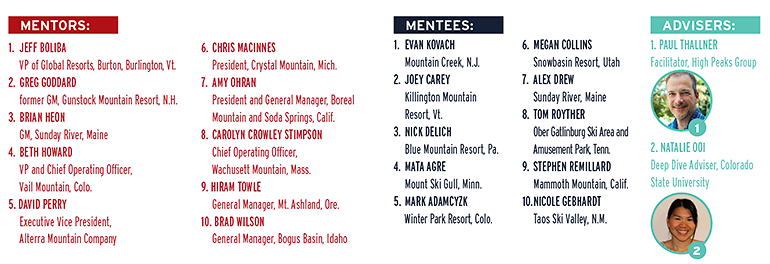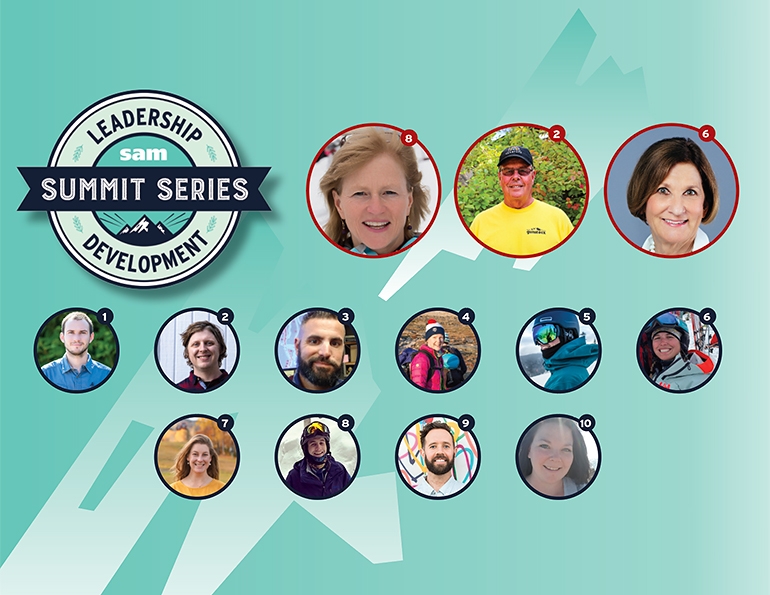

The SAM Summit Series kicked off this past fall with 10 current industry leaders mentoring 10 next-generation leaders. This continued the mentor- mentee dialogue SAM started three years ago to assist the development of the mountain resort industry’s
future leadership.
The mountain resort industry is in a moment of upheaval as a result of the COVID-19 pandemic. Resorts had to end their winter seasons early and many, if not all, furloughed or laid off staff while the world temporarily shut down. As staff return for the upcoming season, it will be more important than ever that industry leaders work to rebuild and relaunch effective teams, as these groups will be the ones determining how we operate in the new normal.
The series’ “effective teams” conversation took place in November 2019, and it’s full of great insights for normal times. To contextualize the excerpts we include here to the current times, we leveraged the expertise of High Peaks Group founder and Summit Series facilitator Paul Thallner.
The three mentors who took part in this discussion are Chris MacInnes, president, Crystal Mountain, Mich.; Carolyn Crowley Stimpson, COO, Wachusett Mountain, Mass.; and Greg Goddard, then general manager of Gunstock Mountain Resort, N.H., who has recently retired after 39 years with the resort.
Some of their comments needed no context. While addressing major transitions in November, Goddard said optimistically, “Every time there’s change, even though it’s a little bit painful, we come out the better for it.”
There is no growth without discomfort—that’s why it’s called work. During this time of transition, it will be important for leaders to set their returning teams up for success in their work while navigating the challenges ahead.
What Makes An Effective Team?
“There are two really important parts to an effective team: The first is the people and the second is the design,” says Thallner. These two components help determine a team’s success, but the design is the one that leaders have the most control over.
MacInnes likened an effective team to an orchestra. “It’s kind of when the magic happens … It’s when we’re all playing our own parts, our own music, but we’re all in tune, and it’s part of a greater score,” she said.
Thallner agrees. “Not only does everyone that’s part of an orchestra know their role, but they also know the music that they’re playing. Which is another important part of a team—the compelling purpose,” he says. “The compelling purpose is one of the six parts of team design that can favor team success, and these six conditions can predict up to 80 percent of a team’s performance effectiveness.”
The Six Team Conditions (for more details on this, see “Getting Back to Work,” pp. 54 and 55):
1. Is it a real team? Does everyone know who is on it? Is it stable and do members share accountability for the job at hand?
2. Does it have a compelling purpose? “It’s when it becomes about the mission and becomes about the work,” said Goddard.
3. Are the right people on the team? Can the team members think in terms of the overall organization and have an ability to work collaboratively?
4. Is there a sound structure to the team?
5. Is there a supportive context around the team? Are there appropriate rewards, access to information and resources, and the right mix of skills and knowledge to do the job?
6. Is there someone coaching the team? This could be an internal or external person who monitors and provides feedback to the team.
Stimpson likened an effective team to knowing when you’ve found “the one.” There is a level of flow that occurs in the processes and the resulting work is successful. Goddard highlighted that there may be friction at times when team members challenge each other’s thinking, but that can be a good thing because the end result is typically stronger as a result of their unique perspectives and experience.
“When I think about a team, an effective team, it’s that the whole is greater than the sum of its parts,” said MacInnes—a sentiment that sums up the six conditions quite nicely.
Relaunching Teams
“The thing to keep in mind in this period is leaders are reconsidering everything,” says Thallner. This includes operations, back-office processes, customer-facing interactions—everything is on the table. “I think the same is true for team formation as well. Leaders would do well to rethink how they set their teams up for success.”
Pandemic or not, Stimpson said it’s critical that all staff feel welcome and leaders foster a great work environment. “Communication is key and helping new people to understand the culture and feel like they’re part of the team,” she said. “It’s super important to keep everyone on the same page.”
It’s been said on several SAM Huddles: You never want to waste a good crisis. Thallner thinks that this crisis is a golden opportunity for leaders to examine the design of their teams. “It makes a lot of sense, as everything is changing, to also look at changing the way we set up our teams for success,” he says.
Resorts may be looking at incorporating quite a few new people into their teams for the upcoming season, or reorganizing existing teams so that they are made up of new groups of returning faces. Hiring and retention were major concerns during the conversation that took place in November, at a time when unemployment was at an all-time low and many resorts were struggling to hire.
Now, however, unemployment is very high due to the coronavirus pandemic, which means the pool for prospective employees is a lot deeper. Resorts can benefit from this opportunity to bring in new and unique perspectives that could help them adjust to the challenges ahead.
Whether teams are new or old, “Focusing on the mission is really the key when you’re talking about transition,” said Goddard.
Do The Ends Justify The Means?
During the Summit Series conversation, Thallner asked the mentors: What is more important to specify with your team—the means or the ends? All three were unanimous that specifying the ends is the key component to communicate.
“Telling people how to do stuff, you don’t necessarily get the best outcome,” said MacInnes. “But helping people understand what the end is, then everyone can contribute to the best way to get there.” Stimpson specified that focusing on the end goal gives a team the flexibility to make it fun along the way.
In these uncertain times, when we don’t know what the end result will look like, how do leaders set up their teams for success?
“Even though the long-range picture may have changed because of all the challenges going on in the world, what a team can do to stay effective is to shorten their line of sight a little bit, and key on the things they know for sure are going to happen,” says Thallner.
We know for sure there is going to be a winter season—what that looks like is still up in the air as the pandemic situation continues to evolve. Regardless, many leaders in the industry are sharing, anecdotally, that their staff are looking forward to getting back to work. Stimpson reminded us in November of something leaders should aim for when welcoming staff—both new and returning: “It’s about the atmosphere, and feeling like you’re part of something that’s worthy.”
About the Summit Series
The SAM Summit Series creates a platform for current industry leaders to share knowledge with aspiring leaders. The program begins with six professionally-facilitated conference calls in the fall between mentors and mentees on predetermined leadership topics.The mentees then complete related exercises with the guidance of Dr. Natalie Ooi, director of Colorado State University’s graduate Ski Area Management Program. Finally, mentors are paired with one mentee each for three one-on-one exchanges. We share the conversations here in the pages of SAM, online at saminfo.com, and in PodSAM, our podcast channel. We thank all our mentors and contributors for sharing their time and expertise.
Special thanks to the Summit Series sponsor, MountainGuard, for supporting the entire effort; to our program partner, High Peaks Group, for facilitating the series; and to Colorado State University and Dr. Natalie Ooi, our Deep Dive Partner, for enriching the mentees’ experience.






